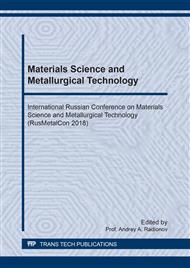[1]
L.B. Khokhlatova, N.I. Kolobnev, M.S. Oglodkov, E.D. Mikhaylov, Aluminum-lithium alloys for aircraft building, Metallurgist, 56(5-6) (2012) 336-341.
DOI: 10.1007/s11015-012-9580-1
Google Scholar
[2]
R.J. Rioja, J. Liu, The Evolution of Al-Li Base Products for Aerospace and Space Applications, Metallurgical and Materials Transactions A, 43A (2012) 3325-3337.
DOI: 10.1007/s11661-012-1155-z
Google Scholar
[3]
V.I. Elagin, V.V. Zakharov, Modern Al-Li alloys and prospects of their development, Metal Science and Heat Treatment, 55(3-4) (2013) 184-190.
DOI: 10.1007/s11041-013-9603-y
Google Scholar
[4]
J. Mizeraa, J.H. Drivera, E. Jezierskab, K.J. Kurzydlowski, Studies of the relationship between the microstructure and anisotropy of the plastic properties of industrial aluminum-lithium alloys, Mater. Sci. Eng. A, 212(1) (1996) 94-101.
Google Scholar
[5]
F.V. Grechnikov, Deformation of Anisotropic Materials: Intensification Reserves, Mashinostroenie, Moscow, (1998).
Google Scholar
[6]
S.J. Hales, R.A. Hafley, Texture and anisotropy in Al–Li alloy 2195 plate and near-net-shape extrusion, Mater. Sci. Eng. A, 257(1) (1998) 153-164.
DOI: 10.1016/s0921-5093(98)00834-x
Google Scholar
[7]
O.A. Setykov, N.I. Kolobnev, L.B. Khokhlatova, M.S. Oglodkov, The influence of the crystallographic orientations on the properties of plates from Al–Li alloys, Tekhnol. Legk. Splavov, 1 (2010) 100-106.
Google Scholar
[8]
Yu.Yu. Klochkova, O.E. Grushko, L.P. Lantsova, I.P. Burlyaeva, B.V. Ovsyannikov, The assimilation for industrial production of semi-finished products from advanced aluminum–lithium alloy V-1469, Aviats. Mater. Technol., 1 (2011) 8-12.
Google Scholar
[9]
X.J. Wu, W. Wallace, M.D. Raizenne, A.K. Koul, The orientation dependence of fatigue-crack growth in 8090 Al-Li plate, Metallurgical and Materials Transactions A, 25(3) (1994) 575-588.
DOI: 10.1007/bf02651599
Google Scholar
[10]
F.V. Grechnikov, S.V. Surudin, Y.A. Erisov, A.O. Kuzin, I.N. Bobrovskiy, Influence of Material Structure Crystallography on its Formability in Sheet Metal Forming Processes, Materials Science and Engineering. 286(1) (2017) 1-7.
DOI: 10.1088/1757-899x/286/1/012021
Google Scholar
[11]
N.I. Kolobnev, L.B. Khokhlatova, M.S. Oglodkov, Yu.Yu. Klochkova, High-strength Al-Cu-Li-alloys with increased fracture toughness intended for aircraft structures, TsvetnyeMetally, 9 (2013) 66-71.
Google Scholar
[12]
Yu.M. Tarasov, R.O. Vakhromov, Application of aluminium alloys, developed under the guidance of academician I.N. Fridlyander, in Russian aviation engineering, Tsvetnye Metally, 9 (2013) 37-39.
Google Scholar


